Believe it or not, Planned Parenthood founder Margaret Sanger did not introduce abortion to the organization. It was a man, Alan F. Guttmacher (after whom the pro-abortion Guttmacher Institute is named), who did so. But Sanger has a very controversial history as an enthusiastic proponent of eugenics and as a member of the American Eugenics Society. The philosophy of eugenics not only fed her work within the Planned Parenthood movement, but her lesser known advocacy of euthanasia as well. The organizations Sanger founded, such as the American Birth Control League (ABCL), and later, Planned Parenthood, also have ties to many eugenics proponents. Under the philosophy of eugenics, minorities and the poor, as well as others deemed to be “feebleminded or unfit” were sometimes sterilized by the state. And at times, state sterilization boards used Planned Parenthood to commit these surgeries.
Sanger’s advocacy of eugenics reveals that her desire was initially to sterilize those she deemed “unfit.” It wasn’t until after these inhumane, eugenic methods were challenged in court that abortion was introduced into Planned Parenthood as an organization.
This clip from the documentary film, Maafa21, recounts a case in which eugenics courts utilized Planned Parenthood’s services to do the dirty work of eugenic sterilizations:
In 1921, Sanger founded the ABCL after opening her first birth control clinic in 1916. In 1923, according to the Margaret Sanger Papers, the Birth Control Clinical Research Bureau (BCCRB) began as the Clinical Research Bureau (CRB), and on January 19, 1939, the Birth Control Federation of America (BCFA) was formed through a merger of the ABCL and the BCCRB. At a special membership meeting held on January 29, 1942, the BCFA changed its name to the Planned Parenthood Federation of America (PPFA).

Planned Parenthood Federation of America Formerly BCFA
Sanger’s obsession with eugenics originated with her introduction to Henry Havelock Ellis in 1914, a psychologist and author of several books on sex, according to biographer Larry Lader. Lader once recounted that Sanger had “skimpy” knowledge about abortion, and that the topic caused a split between Lader and Sanger. “Ironically, I would eventually split with Margaret over abortion — only in a theoretical sense since, by 1963, she was too ill to carry on our old discussions,” Lader wrote in “Abortion II.” “Margaret had always opposed abortion…. Naturally, she was right in the context of her time,” he continued.
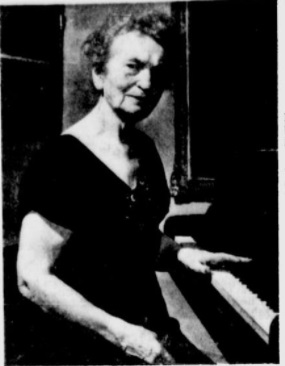
Margaret Sanger (Image Credit Milwaukee Sentinel)
Sanger believed in birth control to “stop the reproduction of the unfit”
Today, thanks to Lader and the media, Sanger is probably most well known for her push for contraception. But Sanger’s birth control agenda had a sinister eugenics plot behind it, as she admitted in 1919, when she stated:
Before eugenists and others who are laboring for racial betterment can succeed, they must first clear the way for Birth Control…. We who advocate Birth Control, on the other hand, lay all our emphasis upon stopping not only the reproduction of the unfit but upon stopping all reproduction when there is not economic means of providing proper care for those who are born in health. …While I personally believe in the sterilization of the feeble-minded, the insane and syphilitic, I have not been able to discover that these measures are more than superficial deterrents when applied to the constantly growing stream of the unfit… Eugenics without Birth Control seems to us a house builded upon the sands. It is at the mercy of the rising stream of the unfit…”
Sanger was a nurse by trade and had witnessed the horrors of illegal abortion. In fact, as early as 1912, before there were appropriate medicines to combat infection, Sanger witnessed a patient die from what she believed to be an illegal abortion. Sanger was not necessarily opposed to abortion, but as it had not yet been legalized, her focus was eugenic sterilization and birth control. In her book Woman and the New Race, published in 1920, Sanger suggests that birth control is a better choice than abortion:
When society holds up its hands in horror at the “crime” of abortion, it forgets at whose door the first and principal responsibility for this practice rests. Does anyone imagine that a woman would submit to abortion if not denied the knowledge of scientific, effective contraceptives? Does anyone believe that physicians and midwives who perform abortions go from door to door soliciting patronage? The abortionist could not continue his practice for twenty-four hours if it were not for the fact that women come desperately begging for such operations…The question, then, is not whether family limitation should be practiced. It is being practiced, it has been practiced for ages and it will always be practiced. The question that society must answer is this: shall family limitation be achieved through birth control or abortion?”
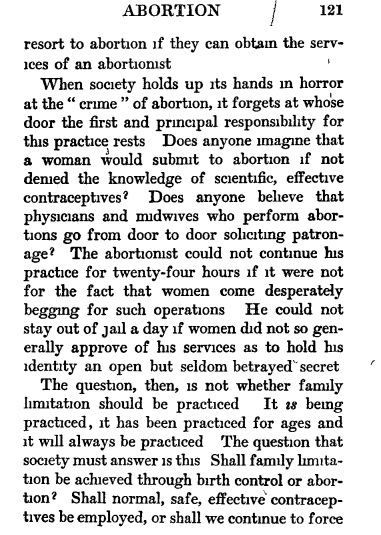
Margaret Sanger talks abortion in Woman and the New Race
As abortion continues today despite the availability of multiple kinds of contraception, it appears that Sanger, in claiming women seek abortion only because they don’t have birth control, was wrong.
Sanger called birth control “less repulsive” than abortion
She goes on to admit, “In plain, everyday language, in an abortion there is always a very serious risk to the health and often to the life of the patient…. Frequent abortions tend to cause barrenness and serious, painful pelvic ailments. These and other conditions arising from such operations are very likely to ruin a woman’s general health.”
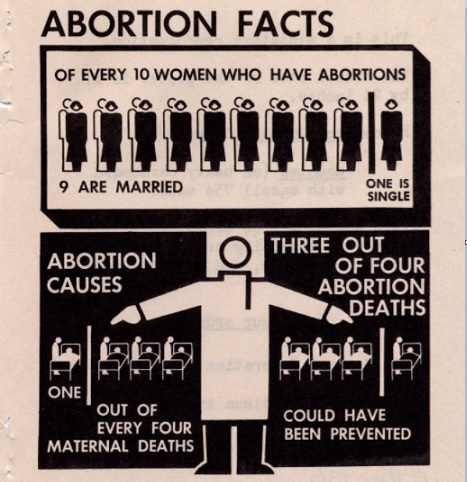
Poster from Birth Control Federation called Abortion Facts
Then, she briefly advocates for legalized abortion, while maintaining her focus on “prevention,” writing, “We know that abortion, when performed by skilled hands, under right conditions, brings almost no danger to the life of the patient, and we also know that particular diseases can be more easily combatted after such an abortion than during a pregnancy allowed to come to full term. But why not adopt the easier, safer, less repulsive course and prevent conception altogether? Why put these thousands of women who each year undergo such abortions to the pain they entail and in whatever danger attends them?”
She goes on to claim that “every argument that can be made for preventive medicine can be made for birth-control clinics,” adding that without these, “the rapid increase of the feebleminded, of criminal types and of the pathetic victims of toil in the child-labor factories,” will continue.
Sanger understood that life begins at the moment of fertilization, writing this in her Family Limitation pamphlet, originally published in 1914: “Any attempt to interfere with the development of the fertilized ovum is called an abortion. No one can doubt that there are times where abortion is justifiable but they will become unnecessary when care is taken to prevent conception.”

Margaret Sanger in Family Limitation noted life begins at fertilization.
In 1921, Sanger proclaimed that “the campaign for birth control is not merely of eugenic value, but is practically identical in ideal with the final aim of eugenics.”
In 1926, as Live Action News has previously detailed, Margaret Sanger met with the women’s branch of the Ku Klux Klan, entertaining additional invitations, according to her own report of the meeting. The event took place in Silver Lake, New Jersey, and Sanger described in it in her autobiography:
I accepted an invitation to talk to the women’s branch of the Ku Klux Klan…. I saw through the door dim figures parading with banners and illuminated crosses…. I was escorted to the platform, was introduced, and began to speak…. In the end, through simple illustrations I believed I had accomplished my purpose. A dozen invitations to speak to similar groups were proffered. (Margaret Sanger: An Autobiography, P.366)
Sanger called that event “one of the weirdest experiences I had in lecturing.”
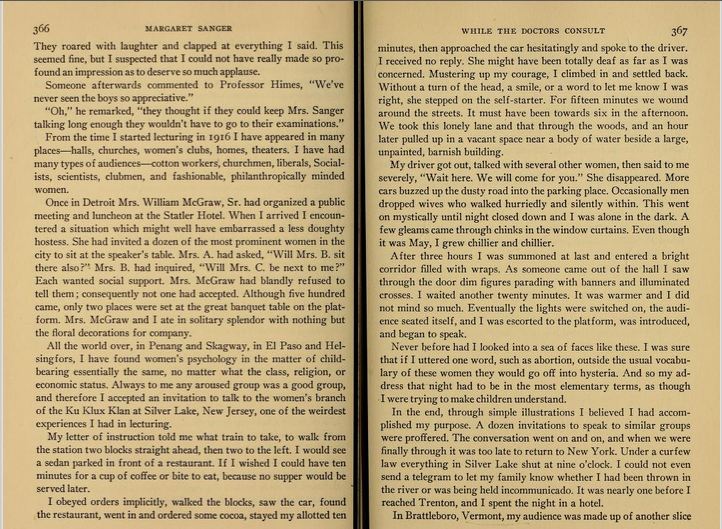
Sanger’s writes about meeting the Klan in autobiography
Sanger believed having children was a privilege (granted by the state), not a human right
In 1934, Sanger suggested requiring a “license” to have children. To the likes of Sanger, the concept of becoming a parent was never one of “choice” but rather something reserved only for the privileged few and only if they obtained the approval of either the government or eugenics leaders.
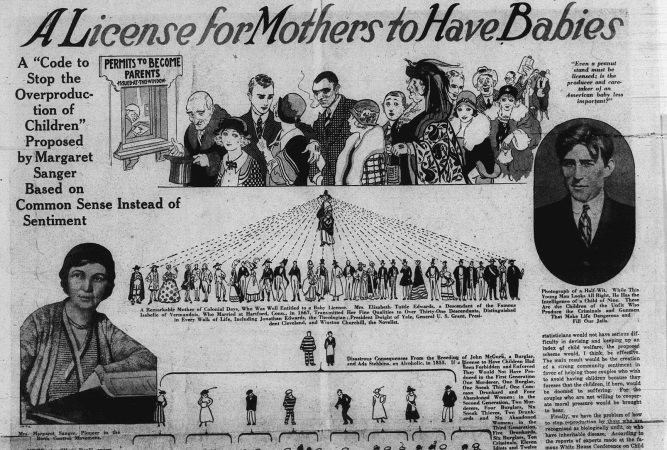
License to Breed Margaret Sanger
In her publication, “A License for Mothers to Have Babies” with the subtitle, “A code to stop the overproduction of children.” Sanger outlined her plan article by article, which read in part (emphasis mine):
A marriage license shall in itself give husband and wife only the right to a common household and not the right to parenthood.
Article 4. No woman shall have the legal right to bear a child, and no man shall have the right to become a father, without a permit for parenthood.
Article 5. Permits for parenthood shall be issued upon application by city, county, or State authorities to married couples, providing the parents are financially able to support the expected child, have the qualifications needed for proper rearing of the child, have no transmissible diseases, and on the woman’s part, no medical indication that maternity is likely to result in death or permanent injury to health.
Article 6. No permit for parenthood shall be valid for more than one birth.
Then, in 1936, Julian S. Huxley, brother of novelist Aldous, who authored Brave New World, published an article in the Eugenics Review, where he proclaimed that birth control had to be taught to the so-called “lowest strata” of society who were “reproducing relatively too fast.” Sanger once said that Huxley “brings to the Birth Control movement the most distinguished intellectual background England can boast.” Huxley wrote:
First comes the prevention of dysgenic effects. The upper economic classes are presumably slightly better endowed with ability – at least with ability to succeed in our social system – yet are not reproducing fast enough to replace themselves, either absolutely or as a percentage of the total population. We must therefore try to remedy this state of affairs, by pious exhortation and appeals to patriotism, or by the more tangible methods of family allowances, cheaper education, or income-tax rebates for children. The lowest strata, allegedly less well-endowed genetically, are reproducing relatively too fast.
Therefore birth-control methods must be taught them; they must not have too easy access to relief or hospital treatment lest the removal of the last check on natural selection should make it too easy for children to be produced or to survive; long unemployment should be a ground for sterilization, or at least relief should be contingent upon no further children being brought into the world; and so on. That is to say, much of our eugenic programme will be curative and remedial merely, instead of preventive and constructive.
Huxley was an outspoken elitist on population control who, in 1946, became UNESCO’s first Director-Genera. He was the vice president of the Abortion Law Reform Association, and like Sanger, he once endorsed euthanasia. Then, in 1959, Huxley was awarded for his work by Planned Parenthood.
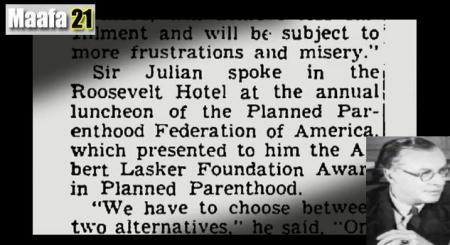
Julian Huxley spoke to Planned Parenthood (Image credit: Maafa21 documentary)
Interestingly, months later in 1937, the American Medical Association (AMA) officially recognized birth control as an integral part of medical practice and education. Then, North Carolina became the first state to include birth control in a public health program. We later learned that they were also heavily influenced by the eugenics movement.
In 1938, Sanger set up a “Committee on Planned Parenthood,” announcing it in her publication, the American Birth Control Review, writing, “As a first step in a campaign to expand the nation-wide activities and services of the American Birth Control League, the Citizens Committee for Planned Parenthood will conduct a fund-raising campaign for $263,990 this Spring in metropolitan New York.”
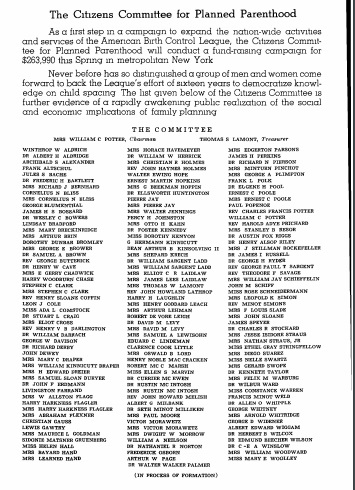
Committee on Planned Parenthood 1938 ABCL
By 1940, the group had raised over $118,000 for the cause with $10,000 coming from Albert D. Lasker.
Planned Parenthood once touted birth control as a way to reduce abortion… but it hasn’t
In 1939, the New York Times used the term “Planned Parenthood” in an article headline, quoting Sanger as claiming that, “The only way to halt the increasing abortion rate and strike at the roots of a racket… is through medically guided birth control advice.”
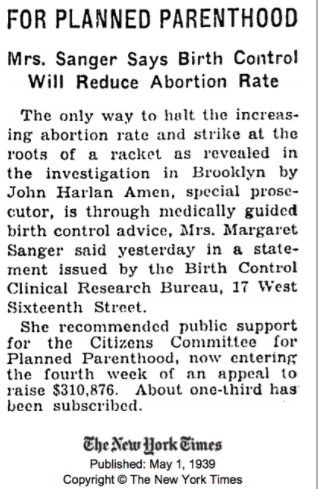
Planned Parenthood mentioned in 1939 in NYT
Behind the scenes, Sanger’s organization was trying to gain the trust of the Black community. Her work in eugenics and her members’ continued advocacy of the very racist movement created some ambivalence. The problem they faced was that the Black community saw birth control and abortion as genocide. But Sanger had a solution: to use Blacks themselves to introduce and promote “birth control.”
Thus, in 1939, Sanger created her “Negro Project,” as described in a letter she penned to Clarence Gamble regarding her desire to use Black ministers in furthering her organization’s agenda, because, she said, “We do not want word to go out that we want to exterminate the Negro population,” and if it did, these ministers could “straighten out that idea if it ever occurs to any of their more rebellious members.”
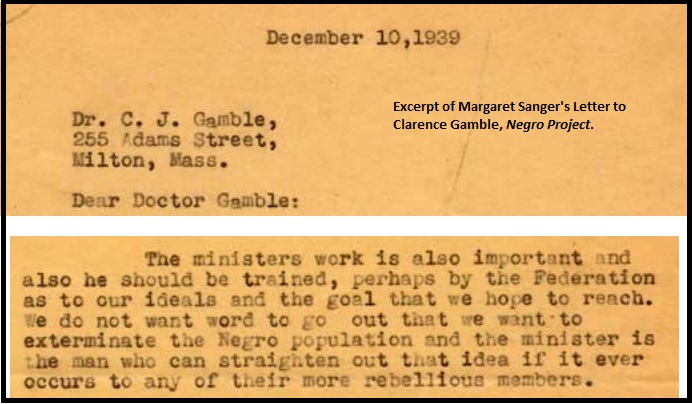
Excerpt: Margaret Sanger Letter to Clarence Gamble, Negro Project
Then, on March 6, 1942, the NYT announced that the BCFA had changed its name to Planned Parenthood.
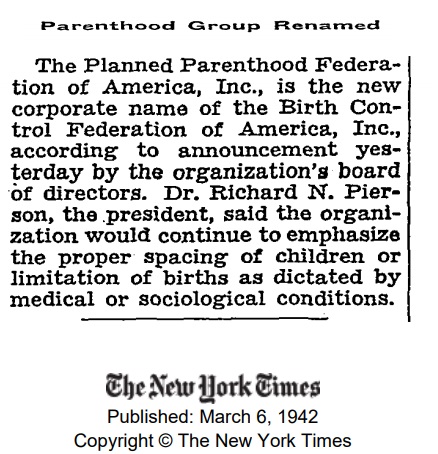
Planned Parenthood founded in 1942 (Image: New York Times)
In 1946, Frederick Osborne, a founding member of the American Eugenics Society (AES) who signed Margaret Sanger’s “Citizens Committee for Planned Parenthood” was elected president of the AES.
Osborn once wrote, “Eugenic goals are most likely attained under a name other than eugenics.” Some speculate that Planned Parenthood’s infamous slogan, “Every Child a Wanted Child,” may have originated with Osborn. It is no wonder that Osborn also said that “Birth Control and abortion are turning out to be the great eugenic advances of our time.”
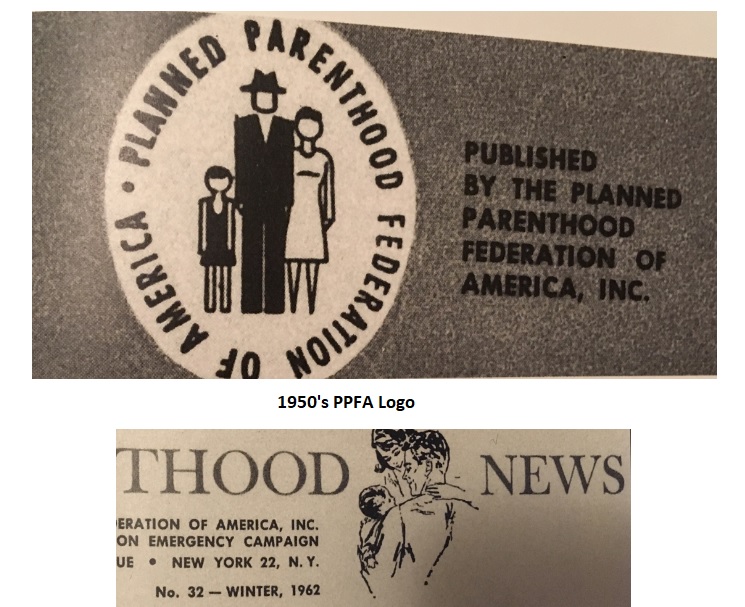
1950’s Planned Parenthood Logos (Image credit: A Tradition of Choice by PPFA)
A few years later, in 1950, Margaret Sanger proclaimed in a letter to Mrs. Stanley McCormick, “I consider that the world and almost our civilization for the next twenty-five years, is going to depend upon a simple, cheap, safe contraceptive to be used in poverty stricken slums, jungles, and among the most ignorant people. Even this will not be sufficient, because I believe that now, immediately, there should be national sterilization for certain dysgenic types of our population who are being encouraged to breed and would die out were the government not feeding them. Contraceptive research needs tremendous financial support…”
The push to add voluntary abortion for “medical, eugenic, and humanitarian reasons” began
Then, in 1959, the American Law Institute (ALI) proposed permitting legal therapeutic abortions. The ALI’s Model Penal Code on abortion was the premise of the 1973 Supreme Court Decision.
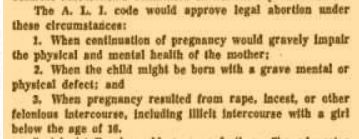
American Law Institute, Model Penal Code on Abortion (Image: Chicago Tribune, 1966)
In 1960, Psychiatrist Dr. Jerome Kummer and Zad Leavey, Deputy District Attorney of Los Angeles, suggested at an annual meeting of the American Medical Association (AMA), that abortion laws be changed to allow for, as the New York Times reported, “medical, eugenic and humanitarian reasons.”
In 1962, Alan Guttmacher, M.D. began his years as president of Planned Parenthood. The following year (1963) Betty Friedan published her book, The Feminine Mystique. Then, in 1964, the platform of the American Eugenics Party was presented and read in part, “The United States is already over-populated. We must stop all immigration and impose birth controls.”
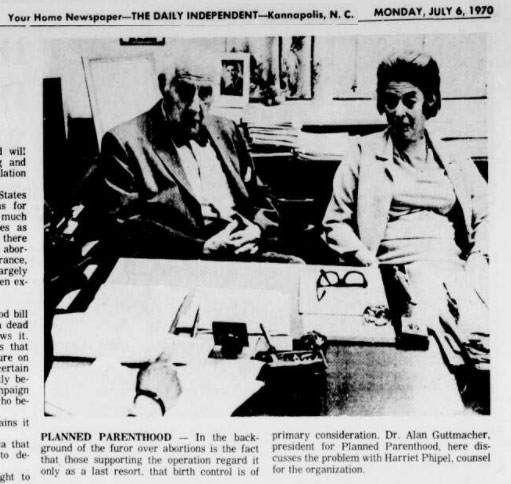
Harriet Pilpel and Alan Guttmacher
In 1965, Harriet Pilpel, general counsel to the American Civil Liberties Union who later became chairwoman of the Law Panel International of Planned Parenthood Federation, according to the New York Times, published The Right to Abortion, calling abortion “the most widespread… method of fertility control in the modern world.”
Pilpel added, “If we really want to cut our population growth rate on a voluntary basis, we should make abortion available on a voluntary basis, at least in the early stages of pregnancy.”
That same year, more pressure was applied to the AMA to adopt a resolution in support of abortion. Sitting on the AMA’s Committee on Human Reproduction was Dr. Mary S. Calderone, a leader in the Planned Parenthood movement and director of SEICUS at the time. She argued, according to the New York Times, that, “A woman should not have to go through with having a baby she will shudder to see.”
Sanger died in 1966, several years before abortion was decriminalized in most states. That same year, Lader published his infamous book, Abortion.
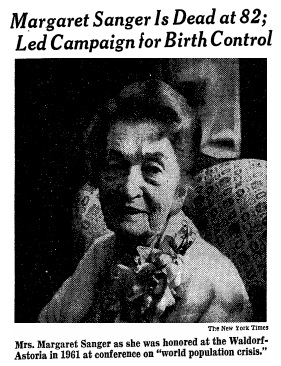
Margaret Sanger Dies 1966
In 1967, Lader and Nathanson hijacked the women’s movement and influenced Betty Friedan to add an abortion plank to NOW. Soon after, in 1969, Lader helped to found NARAL.
Also in 1967, the AMA approved a measure to adopt an abortion policy that would allow therapeutic abortions for the health of life of the mother, to prevent the birth of a child with a physical or mental defect, and to terminate pregnancies resulting from rape or incest.
That same year, California, Colorado, and North Carolina modified their statutes on abortion as well.
The next year, Planned Parenthood would also approve abortion and call for liberalizing laws that criminalized abortion.
This was part one in Live Action News’ series on the history of Planned Parenthood’s move to committing abortions. You can read part two, part three, and part four in additional articles.







